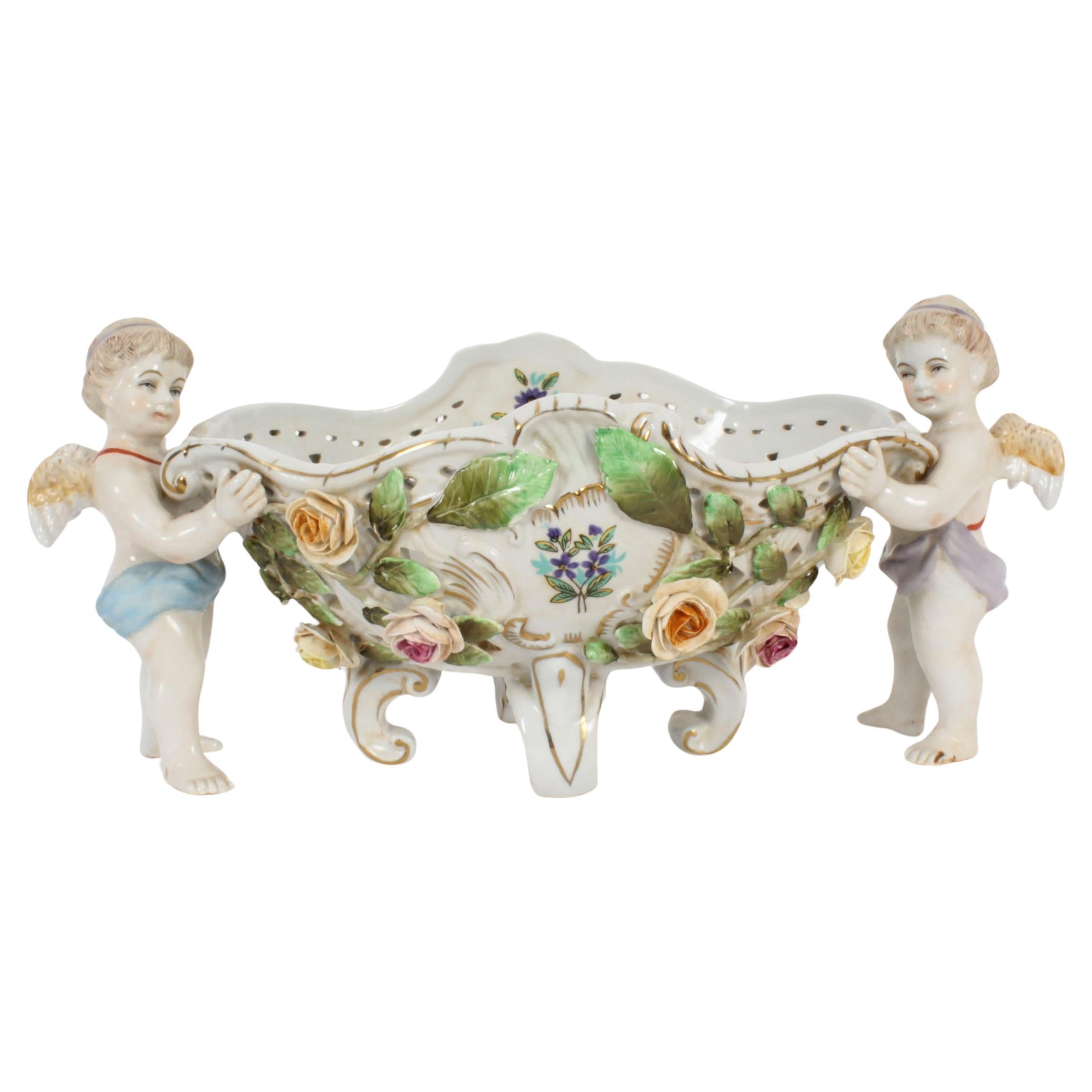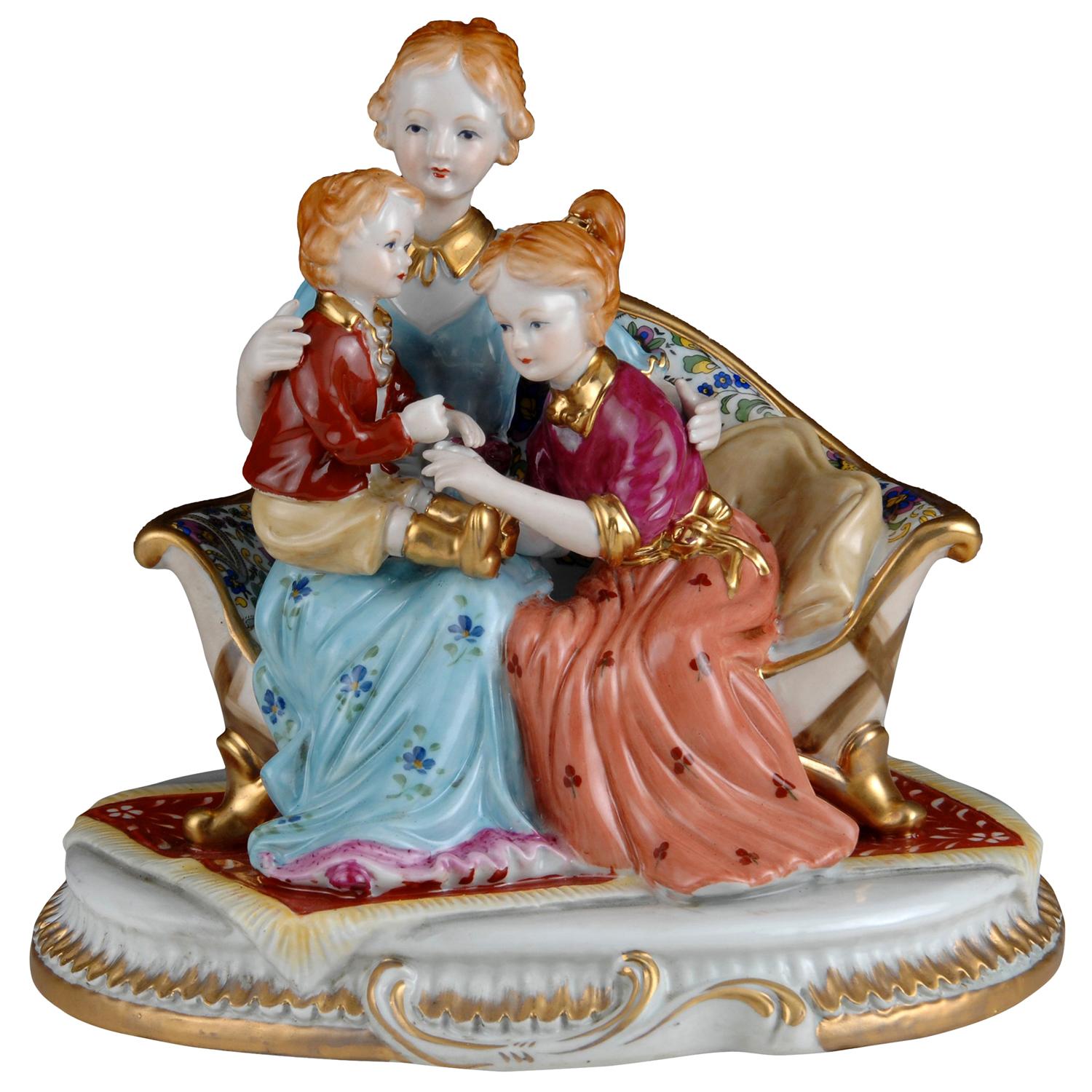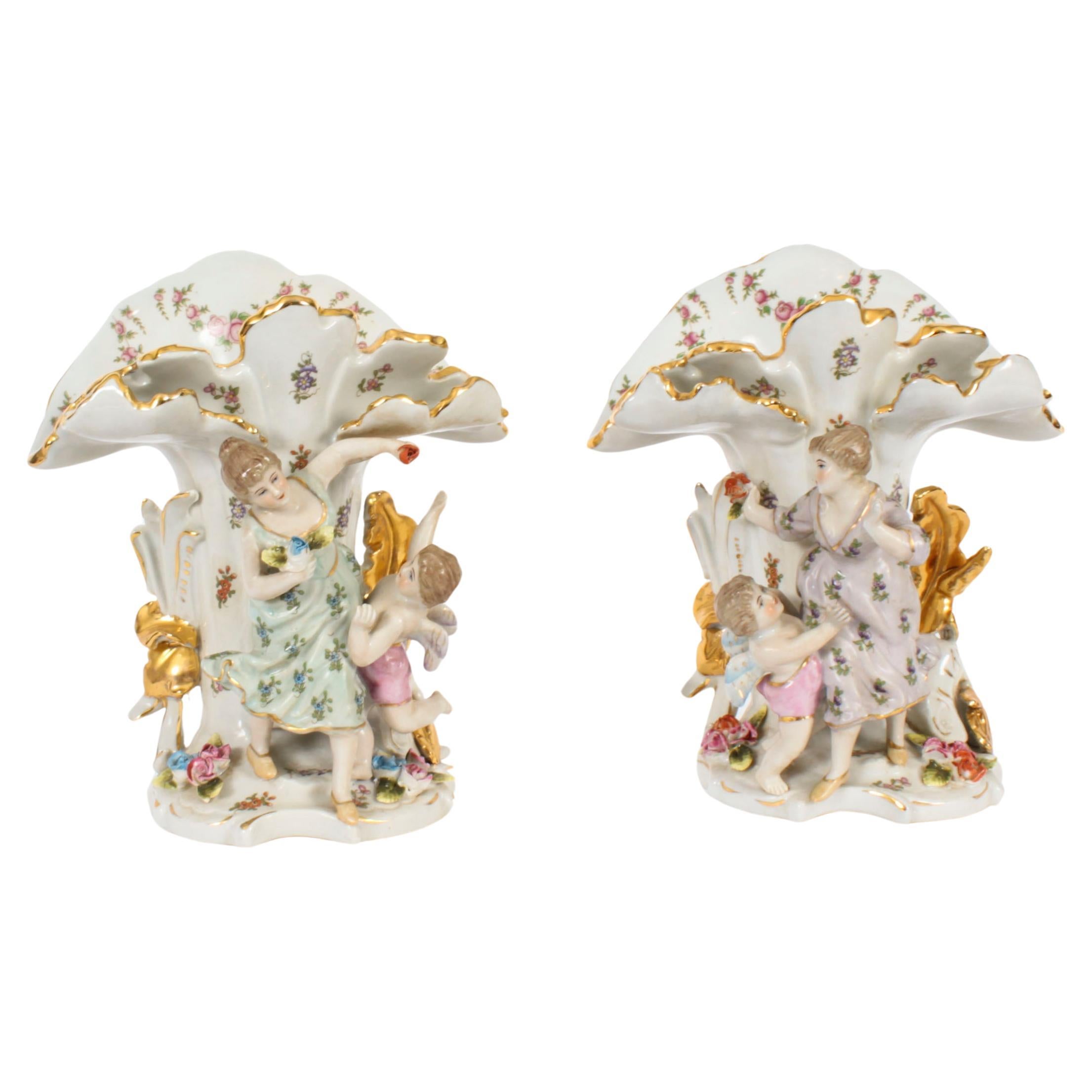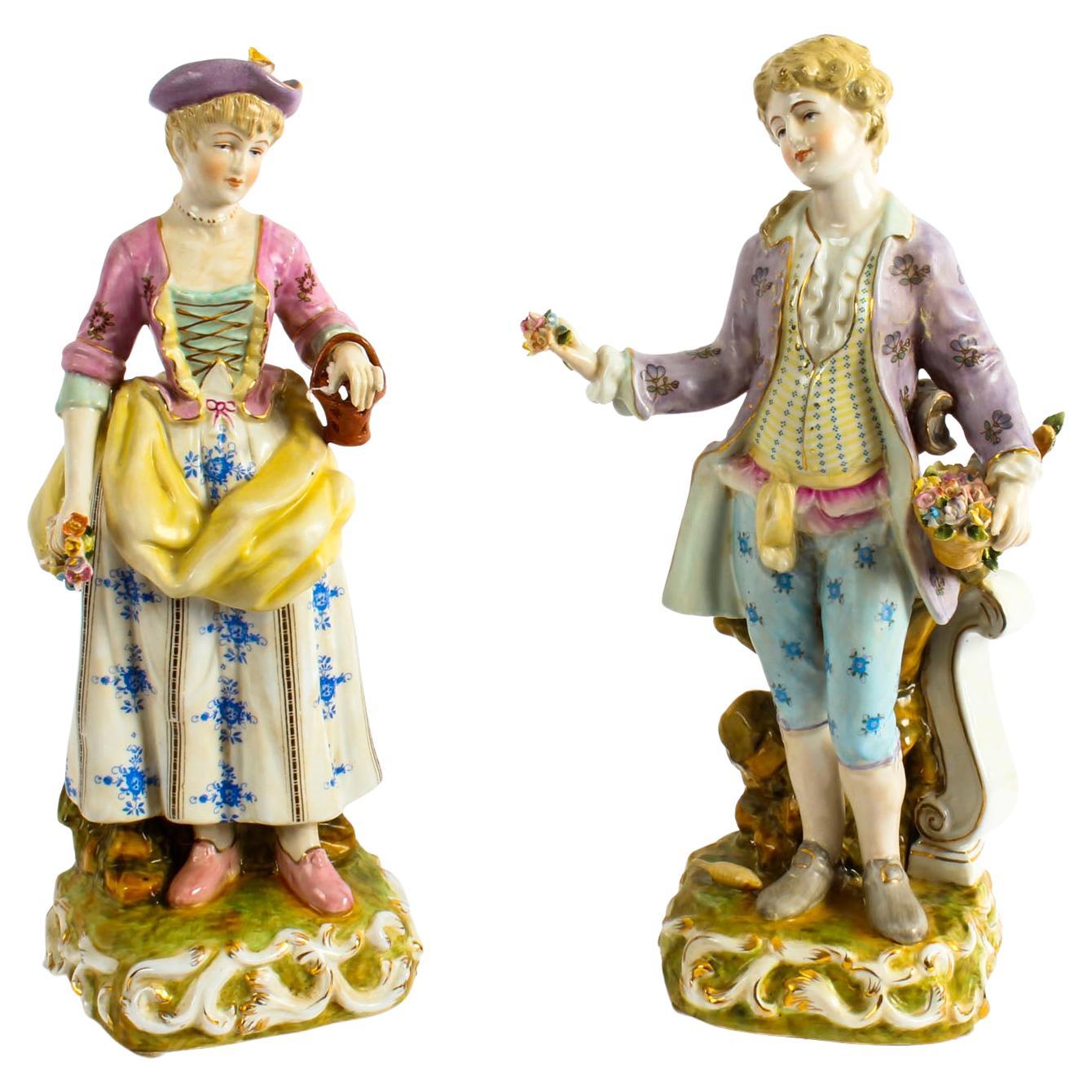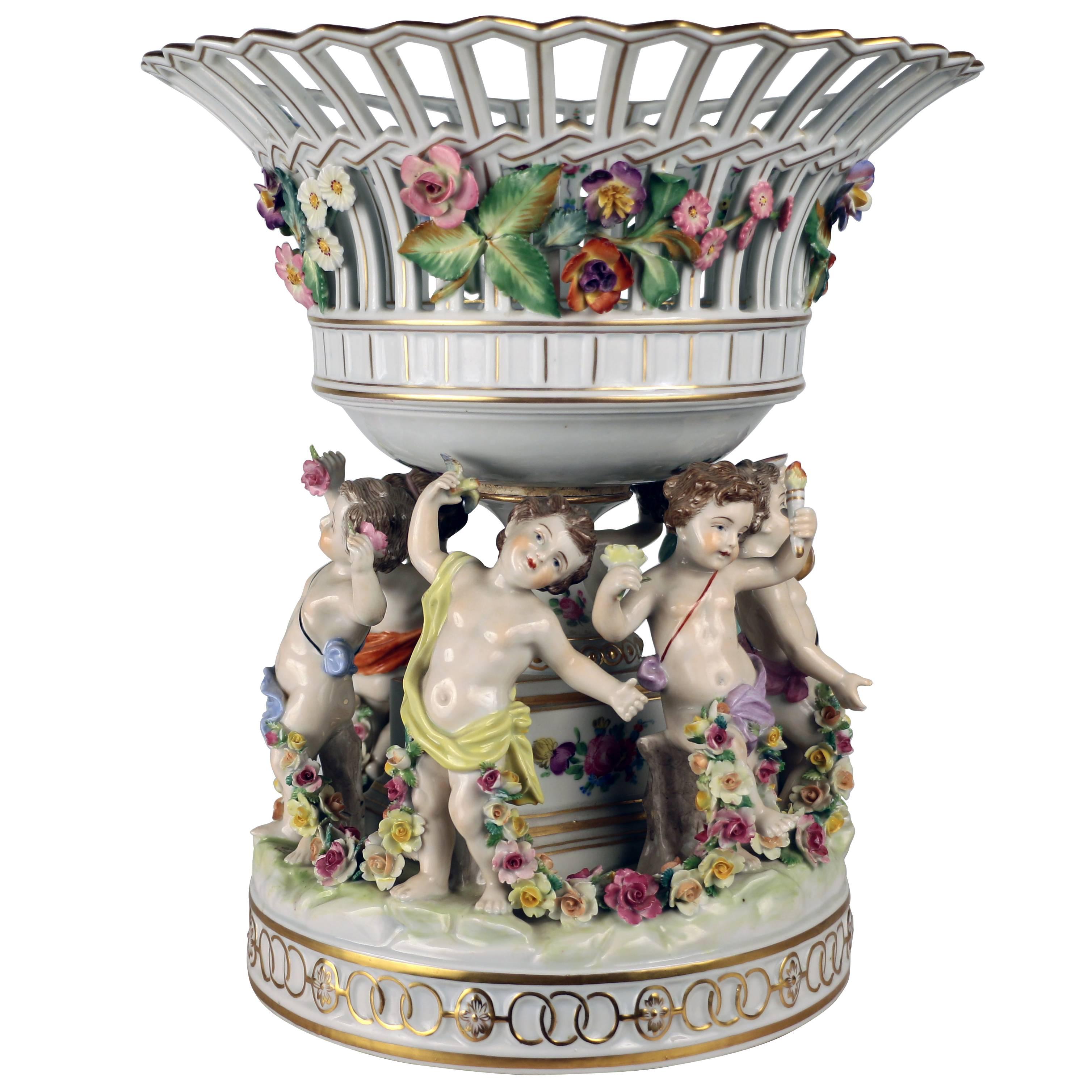Items Similar to Vintage Dresden Revival Porcelain Centrepiece 'Children at Play' 20th Century
Want more images or videos?
Request additional images or videos from the seller
1 of 13
Vintage Dresden Revival Porcelain Centrepiece 'Children at Play' 20th Century
About the Item
This is truly delightful Vintage classical porcelain centrepiece in the Dresden manner, dating from the last quarter of the 20th century.
This stunning centrepiece is hand-painted with an array of bright colours. It features three charming girls playing with animals - two chickens, a rabbit and two chicks - in the garden. It is further embellished with a plethora of exquisite flowers.
It is a very decorative piece which will look lovely in your collection.
Condition:
In excellent condition with no chips cracks or signs of repair, please see photos for confirmation.
Dimensions in cm:
Height 21 cm x Width 24 cm x Depth 18 cm
Dimensions in inches:
Height 8 inches x Width 9 inches x Depth 7 inches
Dresden porcelain - A King's Obsession
In the early 1700s, King Augustus II, prince elector of Saxony, held goldsmith Johann Bottger prisoner and commissioned him to create gold. Bottger instead discovered the method of creating porcelain, a favored and valuable item in the king's eyes.
The king announced to Europe in 1710 that he would open a porcelain manufactory in Dresden. He instead opened one at nearby Albrechtsburg castle. Espionage was rampant, and the king guarded his porcelain secret, even though it meant imprisoning workers within the castle walls.
By 1720, the secret was leaked and porcelain producers popped up in Vienna and Venice. Dresden porcelain adopted Saxon crossed swords in under-glaze blue as its distinguishing mark.
In 1736, the porcelain manufactory produced the "Swan Service." It consists of 1,400 pieces, and is the largest, most lavish porcelain service ever created.
In 1872, Dresden built its own manufactory to better establish its role in porcelain production.
Our reference: A3882
- Dimensions:Height: 8.27 in (21 cm)Width: 9.45 in (24 cm)Depth: 7.09 in (18 cm)
- Materials and Techniques:
- Place of Origin:
- Period:1990-1999
- Date of Manufacture:circa 1990
- Condition:
- Seller Location:London, GB
- Reference Number:
About the Seller
5.0
Platinum Seller
These expertly vetted sellers are 1stDibs' most experienced sellers and are rated highest by our customers.
Established in 1983
1stDibs seller since 2012
1,203 sales on 1stDibs
Typical response time: <1 hour
Associations
LAPADA - The Association of Arts & Antiques Dealers
- ShippingRetrieving quote...Ships From: London, United Kingdom
- Return PolicyA return for this item may be initiated within 14 days of delivery.
More From This SellerView All
- Vintage Dresden Style Porcelain Centre Piece 20th CenturyLocated in London, GBThis is a beautiful and ornate Vintage Dresden Revival porcelain centrepiece, late 20th century in date. The centrepiece features a winged cherub on each side holding an oval pierc...Category
1990s German Porcelain
MaterialsPorcelain
- Vintage Pair of Delightful Dresden Style Porcelain Spill Vases 20th CenturyLocated in London, GBThis is a truly magnificent pair of hand painted porcelain spill vases accomplished in the Dresden manner, dating from the second half of the 20th century. Each vase features a maid...Category
Vintage 1980s German Porcelain
MaterialsPorcelain
- Antique Pair Dresden Lidded Porcelain Vases & Covers Early 20th CenturyLocated in London, GBThis is a beautiful pair of Dresden lidded vases and covers, circa 1900 in date. Superbly painted with panels of figural scenes of courting couples and flowers on a yellow and gilt ground, with underglaze blue Dresden marks to the bases. They are beautiful objects which will look fabulous in most surroundings. Condition: In excellent condition with no chips, cracks or signs of repair, and only very minor signs of wear comensurate with age and use, please see photos for confirmation of condition. Dimensions in cm: Height 32 x Width 20 x Depth 20 Dimensions in inches: Height 1 foot, 1 inch x Width 8 inches x Depth 8 inches Dresden porcelain - A King's Obsession In the early 1700s, King Augustus II, prince elector of Saxony, held goldsmith Johann Bottger prisoner and commissioned him to create gold. Bottger instead discovered the method of creating porcelain, a favored and valuable item in the king's eyes. The king announced to Europe in 1710 that he would open a porcelain manufactory in Dresden. He instead opened one at nearby Albrechtsburg castle. Espionage was rampant, and the king guarded his porcelain secret, even though it meant imprisoning workers within the castle walls. By 1720, the secret was leaked and porcelain producers popped up in Vienna and Venice. Dresden porcelain adopted Saxon crossed swords in under-glaze blue as its distinguishing mark. In 1736, the porcelain manufactory produced the "Swan Service...Category
Antique Early 1900s German Porcelain
MaterialsPorcelain
- Pair Dresden Style Hand Painted Porcelain Figures Late 20th CenturyLocated in London, GBThis is a wonderful pair of hand painted porcelain figures in the Dresden style, dating from the last quarter of the 20th century. This delightful pair features a woman and a man standing tall in grace, adorned in classical garb and holding a basket of lovely flowers at their hands. They are depicted with absolutely fantastic attention to detail. These figures are a perfect addition to your existing collection or a good set to start your own porcelain collection. Condition: In excellent condition, please see photos for confirmation of condition. Dimensions in cm: Height 37 x Width 19 x Depth 15 Dimensions in inches: Height 1 foot, 3 inches x Width 7 inches x Depth 6 inches Dresden Porcelain - A King's Obsession In the early 1700s, King Augustus II, prince elector of Saxony, held goldsmith Johann Bottger prisoner and commissioned him to create gold. Bottger instead discovered the method of creating porcelain, a favored and valuable item in the king's eyes. The king announced to Europe in 1710 that he would open a porcelain manufactory in Dresden. He instead opened one at nearby Albrechtsburg castle. Espionage was rampant, and the king guarded his porcelain secret, even though it meant imprisoning workers within the castle walls. By 1720, the secret was leaked and porcelain producers popped up in Vienna and Venice. Dresden Porcelain adopted Saxon crossed swords in under-glaze blue as its distinguishing mark. In 1736, the porcelain manufactory produced the "Swan Service...Category
Vintage 1980s Porcelain
MaterialsPorcelain
- Antique Pair Dresden Porcelain Pot Pourri Lidded Vases 1920s 20th CLocated in London, GBThis is a beautiful antique pair of fine quality Dresden porcelain pot pourri urns and covers, circa 1920 in date. Each painted with harbour scenes on a patterned ground and bearing underglaze blue AR marks. They are beautiful objects which will look fabulous in all surroundings. Condition: In really excellent condition with no chips, cracks or signs of repair, and only very minor signs of wear comensurate with age and use, please see photos for confirmation of condition. Dimensions in cm: Height 41 x Width 23 x Depth 17 Dimensions in inches: Height 1 foot, 4 inches x Width 9 inches x Depth 7 inches Dresden porcelain - A King's Obsession In the early 1700s, King Augustus II, prince elector of Saxony, held goldsmith Johann Bottger prisoner and commissioned him to create gold. Bottger instead discovered the method of creating porcelain, a favored and valuable item in the king's eyes. The king announced to Europe in 1710 that he would open a porcelain manufactory in Dresden. He instead opened one at nearby Albrechtsburg castle. Espionage was rampant, and the king guarded his porcelain secret, even though it meant imprisoning workers within the castle walls. By 1720, the secret was leaked and porcelain producers popped up in Vienna and Venice. Dresden porcelain adopted Saxon crossed swords in under-glaze blue as its distinguishing mark. In 1736, the porcelain manufactory produced the "Swan Service...Category
Vintage 1920s Porcelain
MaterialsPorcelain
- Vintage Chinese Porcelain Bowl, Mid-20th CenturyLocated in London, GBThis is a lovely porcelain bowl, mid-20th century in date. The shaped oval bowl features a pair of gilt handles and is beautifully painted with a cream ground and brightly colour...Category
Vintage 1950s Chinese Porcelain
MaterialsPorcelain
You May Also Like
- Mother with Children, Porcelain, 20th CenturyLocated in Madrid, ESEnameled porcelain figure inspired by 18th century works of outstanding manufactures such as Sèvres, showing a lady sitting in an sofa and accompanied by a girl and a younger child. ...Category
20th Century European Other Porcelain
MaterialsPorcelain
- Dresden Porcelain Figural Centrepiece Raised Fruit BowlLocated in Montreal, QCThis highly decorative footed bowl, reticulated and painted with flowers, is raised on a charmingly decorative base modelled with dancing putti ...Category
Early 20th Century German Centerpieces
MaterialsPorcelain
- Carl Thieme, Dresden Floral Painted & Gilded Porcelain Urn, Germany, 20th CBy Carl ThiemeLocated in Chatham, ONCARL THIEME (Factory / Manufacturer) - Potschappel (Village / Location) - Empire style Dresden floral decorated and gilded porcelain urn with cover - ...Category
Mid-20th Century German Empire Urns
MaterialsEnamel, Gold Leaf
- Meissen Splendid Centerpiece With Music Playing Children, by Leuteritz, Mid-20thBy Meissen Porcelain, Ernst August LeuteritzLocated in Vienna, ATThe centerpiece was designed by Leuteritz using old forms in Rococo style: High, round rocaille base, centered a high column, covered on the front and back with large rocaille panel...Category
Mid-20th Century German Rococo Centerpieces
MaterialsPorcelain
- Late 18th Century Dagoty French Porcelain Plate Cobalt Blue Children PlayingBy DagotyLocated in Katonah, NYWe are pleased to offer this extraordinary Dagoty porcelain plate showing children playing. The happy children are joined by their dog in a scene painted in grisaille. On this plate, the border of deep cobalt blue is lavishly gilded in a dramatic geometric pattern. As we see here, burnished gilt was another hallmark of Dagoty porcelains. The formal border juxtaposes the informal scene of the children at play with the geometric design. This type of contrast is typically French, and only the French made porcelains with this particular type of sophisticated contrast. Romanticism had a strong influence on the Dagoty porcelains of the last decade of the 18th century. Anecdotal scenes, indoor scenes, and scenes showing children's games replaced neoclassical subjects. The new themes were more human and had a much less rigid atmosphere. Condition: Excellent Diameter: 8 inches Price: $420 Background: The Paris retail shop was on the Boulevard Montmartre. The Dagoty factory made hard paste porcelain. The factory was in the Rue de Chevreuse, Paris, leased for nine years in 1800 by brothers Pierre-Louis (1771-1840) and Etienne-Jean-Baptiste Dagoty (1772-1800). Pierre-Louis became sole owner in 1804, and in 1807 the lease was renewed for a further nine years. The factory was under the protection of the Empress Josephine and supplied porcelain for Versailles. In 1816, Dagoty went into partnership with Edouard Honoré...Category
Antique Late 18th Century French Empire Decorative Dishes and Vide-Poche
MaterialsPorcelain
- Meissen Porcelain Leopard, 20th CenturyBy Meissen PorcelainLocated in Brighton, SussexA charming Meissen porcelain model of a seated Leopard on a white base, signed with the Meissen Blue crossed swords to the base. Batch 71 61587 DSKZN.Category
Vintage 1980s German Porcelain
MaterialsPorcelain
